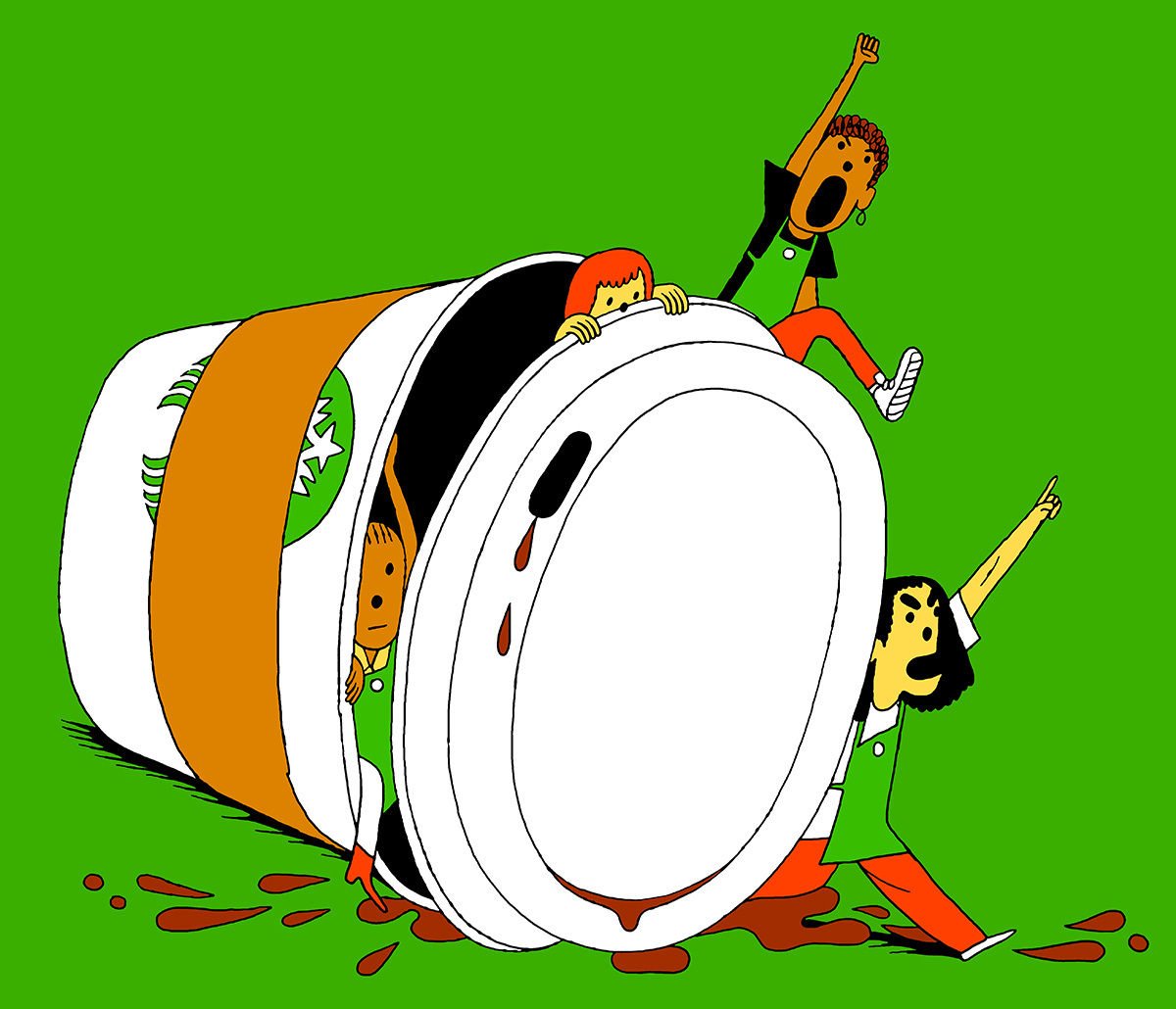
The Starbucks on a leafy corner of Douglas and Alpha Streets in Victoria, British Columbia, appears like any other, but there is one important difference: in August 2020, it became the first corporate-owned location in North America to unionize in recent history. But Sarah Broad, a shift supervisor with about four years’ experience at Starbucks, says, “It started as a little bit of a joke.”
It was the early days of the pandemic. Broad says communication was poor and tensions were high between the company and the store’s thirty or so employees. When it came to COVID-19 precautions, “we were being told one thing and then a week later being told something else,” she says. “We felt like we didn’t know what was going on and like we were being taken advantage of.”
Staff were burned out. They felt they were risking their health for low pay and lacked job security, particularly as hours were cut. The usual routes for complaints—approaching store management or calling the Ethics & Compliance Helpline—weren’t yielding results. Broad’s mother was in a union, and other employees had family members whose workplaces were unionized. From everything they heard, banding together seemed like a better option for the store’s staff than going through corporate channels individually. After about a month of internal discussions, one barista reached out to some unions to gauge interest.
Pablo Guerra, a United Steelworkers union (USW) organizer, admits there was initially hesitation in bringing Starbucks into the fold. But the stories he heard, ranging from challenges acquiring PPE to worker harassment by customers, convinced him it was an important fight. For employees, it usually takes only their time and efforts to launch a union bid, but unions themselves have to cover all the costs of planning and organizing, as dues are collected once a collective agreement has been reached. “It’s not just about money,” Guerra says. “It’s about respect. It’s about dignity.” Shortly after their initial conversations, Broad and more than 90 percent of her colleagues signed union cards. After a final vote, it was official: their Starbucks had joined the USW.
Unions are typically associated with longer-term careers: automakers, public sector jobs, skilled trades. Starbucks, like other food services and retail workplaces, is often viewed as a first job for teenagers or university students seeking a few shifts.
However, the service industry has been undergoing a shift in recent years. According to a 2019 Statistics Canada study, while a majority of minimum-wage earners are under twenty-five, about 45 percent are now older workers trying to carve out a life amid low salaries and often irregular schedules. Since at least the late 1990s, the accommodation and food services sector has had among the lowest unionization rates in Canada, at just 4.9 percent in 2021. But that may be changing, and Starbucks has emerged at the front line.
Workers have been voicing everything from health and safety concerns to problems with understaffing and pay. The company produced record revenues in 2022, hitting $32.25 billion (US) globally, though a full-time barista in Canada might only earn between $15 and $20.45 an hour. Even at the highest end, that’s far below $31.37, the average hourly wage in Canada across all occupations. Some Starbucks workers, fed up with the status quo, say unions can be a solution to the many problems plaguing the sector as a whole.
Today, Broad says, the Victoria store is often contacted by other outlets interested in unionizing. And, though only six stores in BC and Alberta have made the jump in Canada, in the United States, it’s become a flood. In December 2021, an outlet in Buffalo, New York, became the first recent corporate-owned location to unionize in the US. In the twelve months that followed, more than 260 others joined it.
While that’s still a small percentage of the chain’s 10,000-plus stores in North America, the numbers are hard to ignore. But, as many have discovered, organizing—and seeing results—is easier said than done.
Starbucks has a fraught history with unions. In 1985, the company, then nearly fifteen years old, was still a relatively small operation, with a handful of stores around Seattle. That year, some of its employees joined the United Food and Commercial Workers (UFCW), securing benefits like health care coverage and paid vacation for part-time workers.
In 1987, Howard Schultz bought the company and became CEO. As described in his 1997 memoir, Schultz viewed collective action as a sign of poor morale and mistrust among employees, and he sought to quell it. He wrote, “If [workers] had faith in me and my motives, they wouldn’t need a union.”
Schultz began a push to convince workers that organizing went against their best interests. As the number of stores increased, he made claims that Starbucks was a worker-friendly operation, the first US company to offer part timers health benefits. He promoted the line that a direct relationship between employer and employee, without a union getting in the way, would only improve things. Not long after, the workers moved to decertify and leave the union. Yet, as Politico reported in 2019, many of the benefits the company touted were first secured by the union itself.
John Bowman, a former Canadian Auto Workers union organizer, says that, throughout the ’90s and early 2000s, new union attempts would occasionally crop up at Starbucks. Back then, he worked with about a dozen locations in Metro Vancouver that found early, though short-lived, success with unionization. “To me, the organizing is the easier part,” he says. “The real issue is how are you going to build unionization in a workforce of that nature.”
Unionization, no matter the sector, does not mean instant gratification, Bowman says. This can pose a challenge when a movement is still young, as the payoff for workers doesn’t automatically follow a successful vote. It’s also difficult in industries with high turnover. And, in the food services industry, sometimes nearly all of a store’s employees can come and go over the course of a year. As a result, union interest can rapidly shift as advocates leave for other jobs.
Bowman recalls that some people thought it would be easy to bargain with Starbucks due to its progressive image. They believed once headquarters “got over a little snit about [them] unionizing,” they would easily work together. But, Bowman says, this wasn’t the case: though the company uses the right lingo to position itself as worker friendly and socially responsible, he says, it didn’t want to cede any of its power. “They’re really a more sophisticated Walmart,” he says.
This all ultimately proved fatal to those early Canadian Starbucks unions. Eventually, the Vancouver movement fizzled out, and all the unionized stores from the 1990s ultimately moved to decertify. In a statement to The Walrus, Starbucks said, “From the beginning, we’ve been clear in our belief that we are better together as partners, without a union between us, and that conviction has not changed.”
The question for organizers is whether things will be any different now. In the 1990s, full-time baristas weren’t highly paid, but many managed to get by better than they can today as the cost of living was significantly lower. Now, whether workers are in cities like Toronto and Vancouver with sky-high rents or living out in the suburbs, average pay doesn’t meet the necessary living wage. In many Canadian cities, the average rent for a one-bedroom apartment now exceeds $2,000—a cost that would eat up nearly all of a barista’s typical monthly earnings.
For Broad, it’s easy to point out how unionizing has drastically improved her Victoria workplace over the past two and a half years. Grievance procedures are now clear. The common union practice of using seniority when determining schedules means that pay isn’t ruled by a manager’s whims. (Cutting hours as punishment is common in the industry, as is doling out hours to show favouritism.) There’s also a freely available collective agreement, which gives new employees information that can be opaque in the service industry: everything from pay scale to vacation policies and leave requirements.
But that doesn’t mean the process has been straightforward. Broad alleges that, after the successful union vote, Starbucks dragged its feet on finalizing their collective agreement, which wasn’t ratified for nearly a year. (In a statement to The Walrus, Starbucks stated: “In all union dealings, including collective bargaining, we have, and always will engage honestly and in good faith.”) And, in May 2022, the company announced a Canada-wide pay increase—one that, Broad says, excluded the unionized store. Though this “was frustrating to see,” she says, she still feels the decision to unionize was the right one, especially as annual raises are now built into their agreement.
According to Julia Smith, assistant professor of labour studies at the University of Manitoba, there’s a connection between worker activism and times of upheaval, like the two world wars and the Winnipeg General Strike of 1919, which started after high inflation and unemployment spurred about 30,000 people to take to the streets.
But the latter half of the twentieth century saw the labour movement slow down. As employment shifted away from manufacturing, Canadian union membership declined: from 38 percent in 1981 to 29 percent by 2022. In recent years, labour actions, like the fight for $15 minimum wage and attempts to organize gig-economy workers, have attracted attention, but seismic movements have been absent. “We don’t see a lot of those big organizing drives today in the same way, so it can feel daunting,” says Smith.
Organizing food and retail workplaces has proved particularly challenging. The accommodation and food services sector and the retail sector now make up over one in six workers—more than 3 million Canadian employees—but they’re dispersed across a large number of workplaces. While other blue-collar industries like manufacturing may have thousands of workers under one roof who can band together, a single fast-food restaurant may have only a dozen or so. This makes it difficult to build influence. Grocery stores are a rare exception in the sector due to factors such as their large staffs and long history of organizing dating back to the late 1800s. According to UFCW, about 40 percent of all grocery store workers—more than 140,000 in Canada—are part of the union.
It also doesn’t help that many big employers appear to fight unionization attempts with all they have. Walmart has been criticized for closing stores in retaliation for union activity—most notably in 2005, when it shuttered its first North American store to unionize, in Jonquière, Quebec. This past July, Starbucks Workers United, which represents workers at about 200 locations in the US, filed a complaint with the National Labor Relations Board after Starbucks announced it was closing more than a dozen of its stores over safety concerns, which the SBWU claimed was actually in retaliation for union activity. In a statement, Starbucks denied the allegation, and said, “There will be no tolerance for any unlawful anti-union behaviour, if ever found to be true.”
Employees have also accused managers at two Starbucks locations in the US of telling them that unionizing could jeopardize their gender-affirming health care coverage. (Starbucks has denied these allegations.) And, in a company-wide letter, Starbucks said that benefits and wages for unionized employees would “essentially be frozen while the parties negotiate the contract.” Workers allege that the chain is prolonging contract discussions—the Victoria location remains the only one to finalize a collective agreement so far.
Yet, as the effects of COVID-19 continue to ripple through the economy, there are more and more unions formed by workers, from cannabis retailers to Indigo locations, to draw inspiration from. Efforts have also been made at Amazon warehouses in Montreal and Nisku, near Edmonton. “I’m especially excited because it seems like it’s being led by the workers themselves and a lot of young workers,” Smith says.
This was the case in Lethbridge, Alberta (where I once worked during my three years as a barista). The city of about 100,000 was recently host to one of the most ambitious Starbucks union attempts yet. In May 2022, employees at five corporate-owned locations announced they were holding a joint vote to unionize together. A majority of employees signed union cards, leading to an official vote, which was scheduled to take place in July.
By law, there are usually about two weeks between when employees sign their union cards and the official ballots come due in the province—a delay during which the Alberta Labour Relations Board conducts investigations to make sure that the proper procedures have been followed. (A handful of other provinces allow for single-step certification, where a workplace can be unionized automatically if a certain percentage of employees sign union cards.) According to a recent complaint to the board, eleven workers alleged that Starbucks used this time to try to prevent the Lethbridge union from proceeding. They accused the company of “decreasing hours of work during the certification campaign,” “sending a negative message to thwart the Union’s organizing efforts,” and denying one employee’s “transfer request due to his support for and activity in the Union, which lead to his termination of employment.” (Starbucks has denied the allegations, stating, “All claims of anti-union actions or union-busting are false. To be clear, no Starbucks partner has been or will be disciplined or separated for supporting, organizing or otherwise engaging in lawful union activity.”)
When votes were finally counted in September, it was a tie. The union lost by default. Even so, workers say the fight continues. According to one employee, they immediately began planning the next vote: store by store this time rather than all together. In December, employees at the West Lethbridge Towne Centre location were the first to fill in their ballots. As of early January, the results were still being determined.
Broad says, with economic anxiety growing amid predictions of a 2023 recession, now may be a critical time to act. Her union contract offers the job security that’s often absent for her peers at other locations, covering everything from wage increases to hours based on seniority. And, according to the agreement, Starbucks and the union must discuss alternatives before any layoffs proceed. If there’s no other option, they are to be done in reverse order of seniority and feature a recall clause—offering more security than workers had before. “If anytime is going to be successful for this movement, it would be right now,” Broad says, “when people need this extra support more than ever.”







